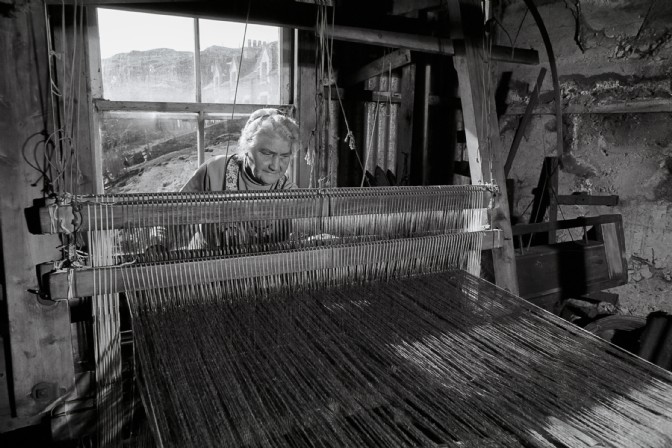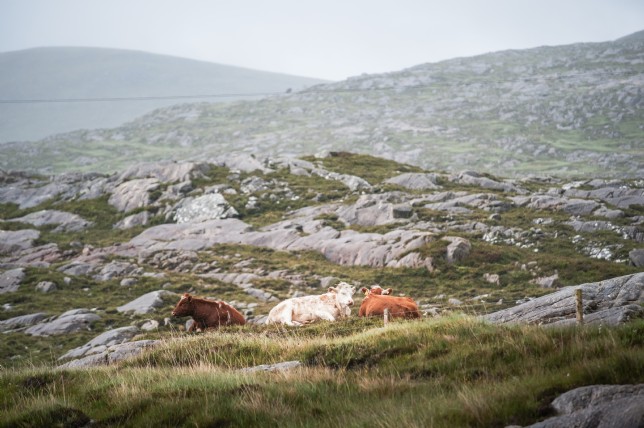This month, we´re spotlighting our incredible isles and those lucky enough to call them home. Here, we speak with a well-known member of the Harris Tweed weaving family, Catherine Campbell, about the material´s iconic journey from its early Hebridean island days to global acclaim.
Can you give us a short bio about yourself?
My name is Catherine Campbell, born and bred on the Isle of Harris on a croft where we were surrounded by many Harris Tweed weavers. It was a way of life around the island.
Harris Tweed is such an iconic brand now, but we’d love to know a bit more about what the early days looked like?
My parents were weavers of Harris Tweed and had a small workshop and shop where they offered weaving demonstrations to visitors and sold their produce. This strongly influenced my love for Harris Tweed. When I was young, Harris Tweed seemed to me quite unfashionable; the colours were dark and the tweed was rather heavy and itchy. It was more popular for outerwear, game keeping, and country wear; where dark, traditional colours are more suitable. Historically, visitors came to see the looms working and buy the cloth that my parents wove in the shop, but rarely did we see the cloth made up. If a customer returned wearing their jacket or coat made from the material to show us, it was wonderful and fascinating to see. We didn't have tailors on the island or factories making garments, so it was rare to see the tweed in-situ, and I immensely enjoyed when we did.
The landscape of the Isle of Harris is that perfect mix of breathtaking beauty and untouched ruggedness. How did that influence the design process?
My father's aunt, Marion Campbell, dyed and spun her own wool on the croft in the early days, therefore we were used to seeing the traditional landscape colours of browns, greys, and greens used within the designs.

Business seemingly catapulted from small-scale island-making to global acclaim. How has the business developed throughout the years?
I was only in my teens when I discovered brighter colours were being made, and this intrigued me. After my father and Marion passed away, I wanted to keep the family business running with my mother in Plockropool (a small settlement on the East coast of Harris). I found, once the tweed was made up into garments, it all just came to life and was complete. This inspired me to try to stock a few items of ladies and gents clothing as well as hats and bags, and so it continued for me. After a few years, I wanted to launch everything in Harris Tweed, including accessories like purses, wallets, cosmetic bags, and household items - products you never usually saw in Harris Tweed. I was particularly attracted to the bright colours and checks for our smaller products. In 2006, we set up an online shop and today we have over 3,000 different items online in Harris Tweed, so it's been a wonderful adventure! Last year I was awarded an OBE for my work in the Harris Tweed Industry which was such a big surprise for me!
Marion Campbell is now heralded as an icon and pioneer in the world of British fashion. Can you tell us some more about her and her legacy?
When I think of all the hard work she put into dying the wool in the dye pot for hours, then drying it, before spinning it all on her spinning wheel when the business started out, it’s very inspiring. It was such a long, hard process before she even began to weave and her loom was an old wooden hand loom where you had to throw the shuttle by hand, unlike the faster automatic looms that are available now. She always wore a Harris Tweed skirt for every occasion, so she is the most famous person I know to wear the family cloth! She was awarded a BEM for her work in the Harris Tweed Industry.

What is the most iconic piece ever made by Harris Tweed in your opinion?
The most iconic piece of Harris Tweed for me has to be Marion Campbell's handwoven Harris Tweed.
If you were to describe Harris Tweed in three words, what would they be?
Hand-woven, heritage, and iconic.
What is island life like on the Isle of Harris? And has it changed much in the last 30 years?
Life on Harris is wonderful, apart from the dramatic weather sometimes! We all know each other so it's very friendly and safe for the children. Although it's a small island, life can be very busy for us all between work, tourism, and family life. Maybe we take our beautiful scenery, the colours of the sea around us, the ever changing clouds and sky for granted. You can travel the world and often not find the colours of the landscape we have here. I would say island life has changed a lot in the last 30 years. It was very industrious long ago as islanders couldn't easily travel for shopping, therefore there were more local village shops, post offices, bakeries, and tourism shops. They worked long and hard on the land and the fishing was plentiful as this was the staple diet. I guess with the progress of large supermarkets, vehicles, and online shopping it has its effects.
What is your favourite way to spend time on the island?
I guess a loom workshop is my favourite place in Harris - looking out onto the sea and the beautiful colours. I think growing up and working amongst the wool and production just never leaves you and, of course, having a stunning backdrop makes it all complete!
We have a property located here called Solas, which overlooks the beautiful Luskentyre Beach. Why, in your opinion, should The Isle of Harris be on everyone’s to-do list?
The Isle of Harris should be on everybody's to-do list because the scenery is incredible; the hills, the sea, the breathtaking beaches. The scenery and colours are very hard to find elsewhere in the world. The islanders are friendly and helpful as you would like them to be, it's safe for children and not overly busy. A place I’m proud to call home.







